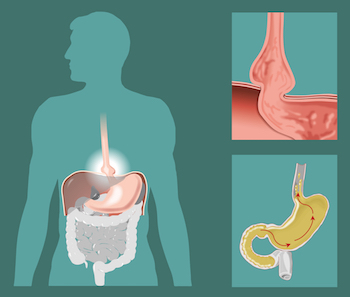Hiatal Hernia Surgery New York
 Hiatal hernias occur when a portion of the stomach and esophagus pushes through the hiatus – an opening in the diaphragm that is intended to separate the chest from the abdomen. The two types of hernias that can occur are hiatal hernias and paraesophageal hernias, with the latter being less common but more serious.
Hiatal hernias occur when a portion of the stomach and esophagus pushes through the hiatus – an opening in the diaphragm that is intended to separate the chest from the abdomen. The two types of hernias that can occur are hiatal hernias and paraesophageal hernias, with the latter being less common but more serious.
A paraesophageal hernia occurs when the stomach moves up into the chest cavity, but the esophagus remains in place. This can result in chest pain and vomiting, as well as a severe constriction of blood supply, called strangulation, which can lead to more serious health conditions.
There seems to be a link between hiatal hernias and Gastroesophageal Reflux Disease, or GERD. While neither directly causes the other, we do know they are linked. As such many people with symptomatic hiatal hernias also have the symptoms of GERD. Further, surgical treatments for hiatal hernia may also include a GERD-related component during the same surgery.
Hiatal Hernia Causes and Symptoms
Hiatal hernias aren’t rooted in a single cause and oftentimes the exact cause cannot be pinpointed. We do know however that anything putting upward pressure on the hiatus can cause a hernia. This can include
- Obesity
- Pregnancy
- Heavy coughing
- Lifting heavy objects
- Straining to go to the bathroom
- and more.
Some people may be genetically predisposed to a hiatal hernia. The risk of hiatal hernias is higher if the patient is female and risks increase with age.
The Symptoms of Hiatal Hernias are Varied
Hiatal hernias often present no symptoms in patients and as such often go untreated or are found while diagnosing other conditions. Common outward symptoms include:
- Many patients who are experiencing hiatal hernias also exhibit symptoms of acid reflux disease
- Chest pain
- Vomiting
Hiatal Hernia Treatment
Surgery is the only effective treatment for a hiatal hernia although there is the possibility of recurrence, as with any hernia. A hiatal hernia can be repaired as a standalone procedure or in conjunction with another procedure. For example, patients undergoing bariatric surgery for obesity may have their hiatal hernia repaired at the same time.
A hiatal hernia may also be repaired during a Nissen Fundoplication for the treatment for acid reflux / GERD.
Standalone hiatal hernia surgery is a straightforward procedure and patients are usually able to go home the next day. Patients can often return to their usual schedules within a week, though heavy lifting and other strenuous activity should be avoided until cleared by our office.
